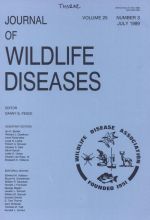Anaerobic and aerobic cultures of facial and mandibular abscesses were made from 12 blue duiker (Cephalophus monticola fusicolor) housed at the Deer and Duiker Research Facility of the Pennsylvania State University (USA). Increases in concentrations of total protein and serum globulin occurred in all cases. Actinomyces pyogenes was isolated from nine animals. Fusobacterium necrophorum was present in eight and Bacteroides sp. was found in seven animals; other genera of isolated bacteria included: Streptococcus (from two animals), Lactobacillus (one), Staphylococcus (one) and Actinomyces (two). Eight (67%) of affected animals were ≤2 yr of age. Facial soft tissues and mandibles were the tissues most often affected. Tissues within the oral cavity were not affected at the time of presentation. A common finding, not reported in other host species with necrobacillosis, was the presence of nondestructive mandibular proliferation.
How to translate text using browser tools
1 July 1989
FUSOBACTERIUM NECROPHORUM AND ACTINOMYCES PYOGENES ASSOCIATED FACIAL AND MANDIBULAR ABSCESSES IN BLUE DUIKER
B. L. Roeder,
M. M. Chengappa,
K. F. Lechtenberg,
T. G. Nagaraja,
G. A. Varga

Journal of Wildlife Diseases
Vol. 25 • No. 3
July 1989
Vol. 25 • No. 3
July 1989
Actinomyces (Corynebacterium) pyogenes
blue duiker
case reports
Cephalophus monticola fusicolor
Fusobacterium necrophorum
pathology
staphylococcal and streptococcal abscesses




